Rosa Caroline Praed, nee M-P
Rosa (or Rosie as she was called by her family) as a young adult.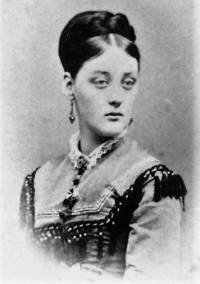 1)
1)
Rosa c1870 in Brisbane  2).
2).
Rosa in 1888.3) 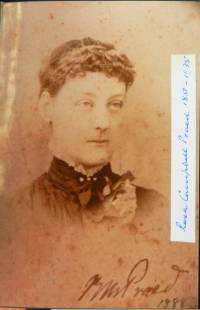
The State Library of NSW has this portrait of Rosa Praed painted by Emily Praed in 1884; it may be a copy of one painted by J.M. Jopling that year. At time of writing (2023), it is in the Library's portrait gallery on open access: 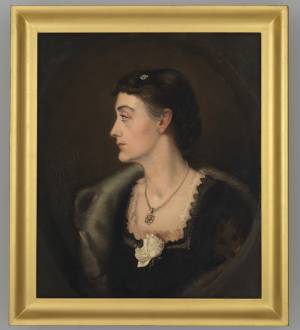
Rosa was a controversial writer, including for her depiction of Indigenous life.4) For an insightful analysis of the discourse around 'race and breeding' in Rosa's novels, see Len Platt5). Some of the attitudes Platt identifies relate to a later period in Rosa's life, but others are consistent with TLM-P's attitudes and actions. A belief in innate good breeding based on (British) class is also consistent with the concern of Rosa's nephew and stepcousin to establish their family's royal descent.
Rosa's writings were also confronting for her contemporaries, notably: 'the young colonial woman's encounter with metropolitan political and literary culture, the 'tragedies of the sexes', the horrors of frontier conflict, and the exploration of psychic and spiritual life.'6) Especially in the 1890s, Rosa was accused of promoting immorality through her more realistic novels, and at least one play, featuring domestic conflict and the plight of women, brought up to be 'innocent' (Rosa would say 'ignorant') and thrust into marriages they had little hope of escaping. These accusations would have been even more strident if her publishers hadn't insisted on bowdlerising her work. Patricia Clarke points out that Australian critics were particularly critical of Rosa's writings as too risque.7)
Given Rosa's notoriety, especially in this era when any publicity threatened a woman's status as a 'lady' and her entire family's claims to gentility, it is noteworthy that she always had her family's support, including that of her conservative father who put so much effort into reclaiming his family's gentry status. In 1880, for example, when TLM-P planned to visited 'home', England, an important aim was to see Rosie.8) A number of her books now in public libraries or offered for sale have affectionate inscriptions in them indicating they were gifts from Rosa to her family.9) One of the last of her books acquired by her father was a special printing of only 230 copies: TLM-P received his copy on 13 March 1890. The book was a loving tribute to the Thames, called The Grey River, and written with Rosa by her friend and collaborator Justin McCarthy, with illustrations by Mortimer Menpes.10) The support she received extended to her wider family - she inscribed on her book The Luck of the Leura, 'To Dr. Lightoller Gratefully acknowledging “The Doctor's Yarn” RM Praed.'11)
TLM-P's support for Rosie's writing was firm but considered. In this era when women's public ambitions were generally trivialised, it is notable that he took her writing career seriously. When he visited her in May 1882, Rosie told him about latest book (her 3rd): 'much interested in it and think it wonderfully written far surpassing anything she has done yet, but must think over it … I went to bed full of her last [book] and was going over it for a long time both before and after sleeping'.12) Rosa's biggest problem was not a censorious father, but one brimming with enthusiasm for her writing and who wanted to help. He also had an understandable desire to protect her from the ramifications of accusations of immorality: 'en route I resumed my sequel of Rosie's story, going into life's feelings and what I would like under these circumstances to happen …would not in my opinion injure the story but would improve it and remove any criticism from goodie goodie people, mine made an interesting sequel. I hope she will adopt it or something similar.'13) The book was Nadine, one that Chris Tiffin considers marked Rosa Praed's 'growing imaginative independence from Australia in that it is entirely set in Britain. Reflecting the contemporary interest in aestheticism, it concentrates on the psychology of a woman who craves excitement, oscillating between elation and extreme depression. Although courted consistently by a stolid lover, in pursuit of sensation she becomes pregnant to a second man, and eventually marries a third, a corrupt Russian prince living in an exciting but morally brittle world. The novel’s success was increased by the open secret that the heroine was based on Olga Novikoff, the so-called “M.P. for Russia”, who was closely linked with [Prime Minister] Gladstone in the 1870s and 1880s. It was this novel which established Praed as a successful writer in the British market and which launched her socially.'14)
By July 1882, when TLM-P was staying with Rosa in England, she discussed the plot of her 4th novel with her father who concluded 'that I think it will be very good'.15) Moloch: A Story of Sacrifice was published in 3 volumes in 1883. The draft plot was daring for the times and one she had to censor for publication. Chris Tiffin summarises it as, 'the young woman marries a cad only to discover that he has previously eloped with her mother and had two illegitimate children by her. … This plot … would have given the reviewers apoplexy'.16) TLM-P had no such reaction. When he read the draft volume I, he concluded it was 'well written and forceable'. He did not 'see anything objectionable … gave opinion to writing a preface & small alternations'.17) The next day he started on Volume II, finishing it in bed that night. He was enthralled: 'So far it is well written, I think the best of Rosie's, the interest is intense…. It got a great hold upon me and I could not sleep but spent a restless awestruck night.' He sympathised with the heroine: “the more I thought the more dreadful (awful) Generras['s] position'. His concern was that the public would not understand Rosa's aim: 'No doubt the book would create a great sensation and taken as meant would do good, but the majority could not understand'. He suggested to Rosie that the heroine discover the truth in time for her to call off her marriage, and 'after a long time' she might marry her first love. 'The plot would not be so intense, but the objectionable part would be taken out and the book be still made to follow out the intention of the author. … Will Rosie see it as I do?'18) He thought that she did. The next day, he 'settled down to read the 3rd vol.' and talked about the novel to 'Rosie who agreed with me and had had the same said before. She sees her way to make the alteration proposed and otherwise she thinks [will] improve “Moloch” without much trouble and have it ready for next February.'19) His support for Rosie shows in other ways, including going with her to her publisher, and helping her move house when the Praeds moved to London.20)
One problem with how Rosa's books are currently read is that modern readers do not appreciate that mixing memoir and fiction “was not considered a fault in Victorian Life-writing” (Megan Brown and Lucy Sussex, Outrageous Fortunes:The Adventures of Mary Fortune, Crime-writer, and Her Criminal Son George, La Trobe University Press, 2025). Rosa had a novelist's imagination and wanted - at times, needed - to sell her books. She did not write them as documentary evidence for future historians.
Photos of Rosa are largely missing from Nora and TLM-P's albums, most likely given to Colin Roderick when assisting him to write his biography of Rosa. The following damaged one from the latter album is labelled 'Rosie Prior & Lizzie Jardine (Mrs Wilbraham)'. The Lizzie Jardine here is John Jardine's sister; Wilbraham was her married name. When Lizzie M-P married John Jardine the two Lizzies became sisters-in-law.
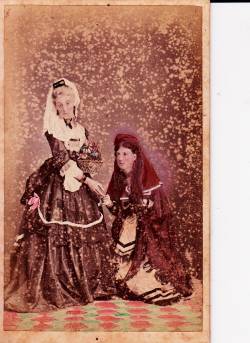
Rosa's husband was the ambitiously named Englishman, Arthur Campbell Bulkley Mackworth (known as Campbell) Praed. In the late 1880s/early 1890s, they lived in the prestigious locality, 16 Talbot Square, Hyde Park, London.21) The next photo from Nora M-P's album appears to be of Campbell Praed.He did not retain his youthful good looks: when TLM-P visited the family in 1882, he recorded that Rosie looked 'better than he expected, though worn' while Campbell was 'very stout weighing 15 stone'. This was an exaggeration -later TLM-P recorded that Campbell weighed himself and was 13 stone 5lb.22) TLM-P was especially delighted with Rosie and Campbell's boys whom he described as 'fine healthy little fellows … boys splendid'. As he mentions only two boys, it is likely that they were the younger ones, with the eldest at boarding school. Campbell had his brewery nearby which he was then expanding to include aerated water and other drinks.23)
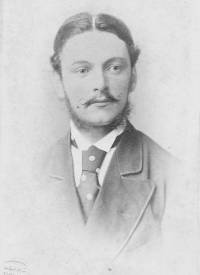

 24)
24)
Rosa and Campbell Praed illustrate the popular saying about marrying in haste and repenting in leisure. They had four children, after which they they lived together, but considered the marriage over. Nevertheless, Praed encouraged and supported Rosa with her career as a writer. He also provided a gracious style of living at Woodlands their home in England. 25) She only left him in c.1899-1900, a year before his death, to live with spiritualist Nancy Harward. Rosa believed she and Nancy were re-incarnated 'twin souls', destined to be together in succeeding lives: a more sceptical modern view is that Nancy's memories of 'past lives' derived from schizophrenia. Despite her spiritualist belief, and perhaps influenced by Justin McCarthy, in 1891 Rosa formally converted to Catholicism. She later changed her mind. Before her death in 1935 she drew up a second codicil to her 1931 will asking to be buried with Protestant rites in All Souls Kensal Green Cemetery, London, sharing the grave of her companion for so many years, Nancy Harward. By then she lived at 2 Palermo Lower Erith Road, Torquay, Devon. Her step-sisters Dorothea and Ruth Murray-Prior were two of her four executors.26)
25) She only left him in c.1899-1900, a year before his death, to live with spiritualist Nancy Harward. Rosa believed she and Nancy were re-incarnated 'twin souls', destined to be together in succeeding lives: a more sceptical modern view is that Nancy's memories of 'past lives' derived from schizophrenia. Despite her spiritualist belief, and perhaps influenced by Justin McCarthy, in 1891 Rosa formally converted to Catholicism. She later changed her mind. Before her death in 1935 she drew up a second codicil to her 1931 will asking to be buried with Protestant rites in All Souls Kensal Green Cemetery, London, sharing the grave of her companion for so many years, Nancy Harward. By then she lived at 2 Palermo Lower Erith Road, Torquay, Devon. Her step-sisters Dorothea and Ruth Murray-Prior were two of her four executors.26)
There are numerous photos of Rosa Praed and her family in the State Library of Queensland including: Rosa in Brisbane in 1894  ; Rosa aged 71 years old
; Rosa aged 71 years old  Rosa arranging flowers
Rosa arranging flowers  27)
27)